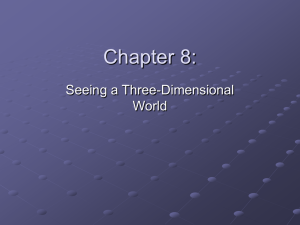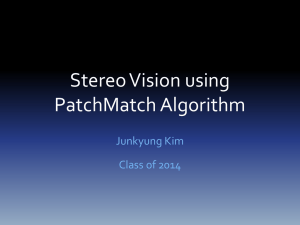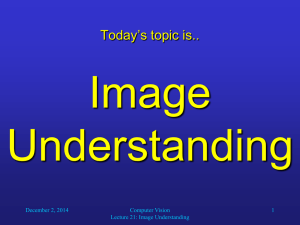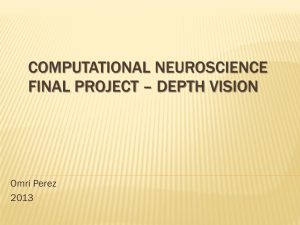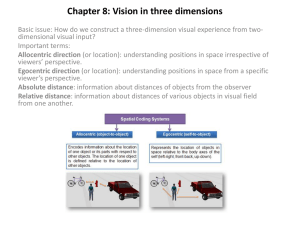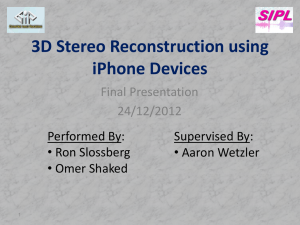Monocular Cues to Depth
advertisement
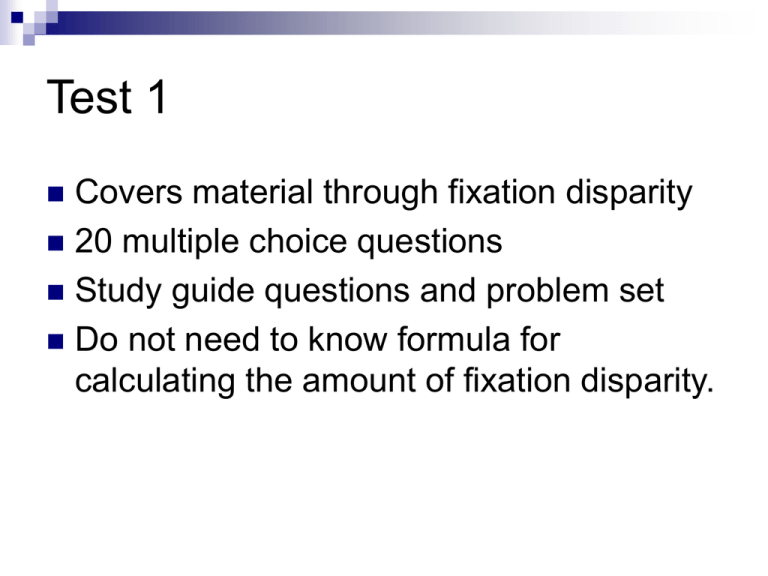
Test 1 Covers material through fixation disparity 20 multiple choice questions Study guide questions and problem set Do not need to know formula for calculating the amount of fixation disparity. Cues to Depth What happens when you close one eye? Still appreciate depth Monocular cues help us with depth perception. Patient’s often confused about this. Characteristics Cues not hard wired Learned inferences that the visual system makes. Monocular Cues to Depth in a deprived environment Retinal image size-this cue works when other cues are absent Emmert’s law – the perceived size of the object producing a retinal image of given fixed size is proportional to its perceived distance. Emmert’s Law Example Afterimage Problem with using retinal images We do not perceive real life objects based on visual angle. Familiar objects would be growing or shrinking Need an invariant or constant to compensate for retinal image size Holway/Boring Experiment Size Constancy Perception needs to account for both distance and retinal size S=K(RxD) S is perceived size K is a constant R is retinal image size D is perceived distance Monocular Cues in Natural Setting See website this is different than in lecture notes. http://sites.sinauer.com/wolfe3e/chap6/star tF.htm Stereopsis This is true depth perception. Preattentive Absolute Depth Distance from egocentric position More dependant on monocular cues Relative Depth Objects in relation to each other Stereopsis ideal for detecting this Types of Disparity Horizontal vs. vertical disparity Other types of disparity Disparity gradients give rise to tilted surfaces Orientation disparity Types of Disparity Horizontal vs. vertical disparity Other types of disparity Disparity gradients give rise to tilted surfaces Orientation disparity Special Cases Chromostereopsis Result of chromatic aberration Longitudinal vs transverse Stereoacuity Depth discrimination threshold Hyperacuity similar to vernier acuity – can get 4 to 5 seconds of arc Howard-Dolman Calculating disparity – Howard Dolman Apparatus n = 2a/2.9 x 10-4 x d/d2 n = angular stereoscopic disparity in radians 2a = interpupillary distance d = fixation distance change in d = linear distance between the two rods Characteristics Effect of exposure time Retinal eccentricity Background illumination Measuring Stereoacuity Howard Dolman apparatus Method of adjustment Method of limits Stereopsis upper limit Patent or quantitative stereopsis Latent or qualitative stereopsis Purpose of coarse stereo Processing of depth outside the horopter Cue for the vergence system Back up stereo system May be primary stereo signal for small angle strabismus. Stereo Targets Local stereopsis Line targets Provides monocular cues Best used for Stereoacuity measures Global Stereopsis Random dot stereogram – provides no monocular cues to depth May play a role in detecting camouflaged object Targets have to be fused for form perception to occur Characteristics Stereo correspondence problem or how does the visual system decide which dots to fuse. The visual system yields the best global interpretation of depth Depth averaging Characteristics Takes longer to perceive global stereopsis Can have good stereoacuity but poor global stereopsis. Implications Methods of Presenting Stereo Targets Linear displacement methods Vectographic methods Polaroid Anaglyph Local and Global stereopsis Howard-Dolman Local Linear displacement Far point measurement Rods appear equidistant No head movement Influenced by skews in the horoper Verheoff Local test Can be used at a variety of distances Monocular and stereo cues conflict Uses relative size 8 settings Verhoof Decimal Stereoacuity Distance Decimal Stereoacuity Binocular Disparity 2.0m (200) 2.0 8.25 1.5m (150) 1.5 14.67 1.0m (100) 1.0 33 Clinical linear displacement Frisby-Davis 2 Distance stereo test Local test Frisby Uses plates for near testing Global test Frisby No Glasses Stereograms Randot E Use at variety of test distances Titmus or Stereofly Common in ophthalmology Randot Stereo Test Newer Version Randot Preschool Stereoacuity Test Distance Randot Stereotest TNO test Red/Green anaglyph Global test Magic Eye Wallpaper stereogram See website chapter 6 Eye Alignment and Stereopsis How accurate does the vergence need to be for optimal stereoacuity? Can a strabismic patient see stereo? Stereopsis and Phoria Exophoria up to 7 prism diopters had little effect on stereoacuity Esophoria beyond 1 diopter associated with an increase in stereoacuity with each diopter increase in phoria. Exophoria has less impact on fixation disparity than esophoria FD and Phoria-Distance Stereopsis in Strabismus Leske & Holmes 2004 Measured stereopsis using three clinical tests Frisby (global) Pre-school stereo test (global) Titmus (local) Stereopsis in Strabismus Leske & Holmes 2004 Titmus tests has monocular cues leading to false positives No true stereo responses in strabismus greater than 4 PD. Positive stereo response on all 3 tests. Measuring Stereoacuity Most patients with normal binocular vision will get all targets. Most patients with constant strabismus (Greater than 4 PD) will get no stereo or false positives. Measuring Stereoacuity Fawcett study (2004 JAAPOS) Measured stereoacuity in treated patients with abnormal binocular vision using Preschool Randot, Titmus Circles, and Randot Circles. This was compared to a normal binocular vision group. Measuring stereoacuity Fine < 60 seconds Moderate 70 to 200 Coarse 400 to 800 Nil-not measurable Measuring Stereoacuity Fawcett study (2005 JAAPOS) All normals able to correctly identify all levels of stereo presented Better stereoacuity with local stereopsis tests. Blur and stereopsis How does bilateral blur impact stereoacuity? How does unilateral blur impact stereoacuity? Stereopsis and Blur Monocular blur has greater impact on stereoacuity Can be a more than double decrease at higher add powers McKee and Westheimer Experimental measure with highly trained subjects. Sample subject started at 6 seconds of arc Binocular blur +1.50 - 10 sec +2.50 – 37 sec Monocular blur +1.50 - 13 sec +2.50 – 77 sec Kirschen et al, 1999 Measures stereoacuity in 19 successful monovision patients. Mean age of 52. Compared stereoacuity in habitual monovision versus Acuvue bifocal contact lens. Mean stereoacuity in the monovision was 200 sec and bifocal was 50 sec Does the patient need good stereopsis? Prevent problem from arising through early intervention Occupation demands Stereo advantage? Can you do certain tasks better with normal stereo? Do individuals without measurable stereopsis (fine stereopsis) adapt to this condition? Functional impact of stereopsis O’Connor et al Purpose of study: functional impact of stereoacuity deficits in eye hand coordination tests. Methods: compared motor ability in normal stereo and stereo deficit (strabismus) on three eye hand coordination tasks. Pegboard test Bead task (small and large) Water pouring task Functional impact of stereopsis Results: Pegboard and bead task significantly worse in the no stereo group. The normal stereo group had a significant performance drop off when performing the task without stereo (monocular condition). Conclusion: recommend early treatment to recover stereopsis or prevent loss of stereopsis. Sheedy et al study 18 presbyopes with a mean age of 52 New cases fit with monovision Measured performance at dispensing, 2 weeks, and 8 weeks. Tasks done with habitual monovision and with binocular distance vision correction with reading glasses. Sheedy et al study Compared performance in 3 tasks; pointer and straw, card filing, and editing All tasks showed a small but statistically significant reduction in performance that persisted after 8 weeks of CL wear. Patient still preferred monovision and did not notice performance reduction. Stereoscopes Two types Wheatstone Brewster Wheatstone Septum device that uses mirrors Usually set for near viewing – typically 33 cm Has a scale of convergence and divergence Can use +3.00 to simulate distance Brewster Septum device that uses prisms and plus lenses Usually +5.00 with a separation of 95 mm which creates a Base out effect. Target distance of 20 cm Brewster Vergence Demand Target separation: h = S(in millimeters) x u (in meters) x dioptic lens power At 20 cm 2 mm equals 1 prism diopter Effect of instrument on the vergence system Brewster Vergence Demand Target separation: h = S(in millimeters) x u (in meters) x dioptic lens power At 20 cm 2 mm equals 1 prism diopter Effect of instrument on the vergence system Vectograms and Stereopsis Polarized targets used in VT Introduce disparity Size Changes Depth Changes Cue Conflict SILO vs SOLI 3-D displays Increasing use in movies and home television Monocular cues to depth were primary depth cues History- popular in the 1950’s using redgreen glasses but audiences got lots of discomfort and poor stereo effect. Types of displays Passive Polarization The Real D Passive wavelength multiplexing Active shutter systems Autostereogram Clinical Concern Visual discomfort during viewing Estimates of 5 to 20 percent of viewers 5% stereoblind Simulated environment creates potential conflicts between accommodation and vergence. This is similar to relative vergence measures where accommodation is at the target plane but disparity vergence is changing. Implications Tests of relative accommodation or vergence create conflict between the two systems. Vectograms also do this Clinical Concerns Very little research on why 3-D effect induces visual discomfort in certain individual. Could become more common clinical question as more individuals interact with 3-D displays Possible factors impacting comfort Amount of disparity in the image Accommodation vergence mismatch Zone of comfortable viewing Depth of focus Limits in the vergence system vergence ranges or panums area Distortions Accommodation/Vergence Depth of focus and distance Pulfrich Phenomenon Inducing the effect Place neutral density filter over one eye Patient perceives an object moving in depth. Pulfrich Phenomenon Increases the time gap between stimulus onset and perception Temporal disparity that creates the perception of depth. Filter over left eye creates a clockwise motion Etiologies Optic nerve disease, Unilateral glaucoma, Retinal pathology Systemic disease Trauma Amblyopia Symptoms Driving Moving or parked cars appear to curve Difficulty of parking Walking Difficulty crossing roads Home Misjudgment when pouring liquids Symptoms Sports Difficulty with ball sports Spatial judgments Moving objects appear to swerve Sense of imbalance Motion sickness Case Report 42 year old female who had difficulty with driving (needed to swerve car because other cars were getting to close) also had difficulties with doing photography. Displayed a positive Pulfrich phenomenon using swinging ball. Case Report The pulfrich phenomenon was neutralized by either a 0.6, 0.8, 1.0 neutral density filter over the right eye. Patient was prescribed asymmetrical tints in each and this resulted in a reduction of symptoms, especially when driving. Stereopsis and Phoria Stereoacuity starts to decrease with increasing amounts of fixation disparity May not see this clinically because most clinically based stereo tests only measures down to 20 seconds of arc.
